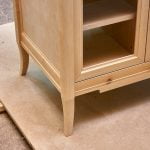What do the Japanese use for making in woodworking? The rich tradition of Japanese woodworking is a time-honored practice that has been passed down through generations. From the use of traditional tools to the intricate techniques employed, Japanese woodworking is steeped in history and cultural significance.
The history of Japanese woodworking dates back centuries, with a deep-rooted connection to the natural environment and spiritual beliefs. The art of woodworking in Japan has evolved over time, influencing modern woodworking techniques worldwide.
One of the key aspects of Japanese woodworking is the use of unique and traditional tools, as well as specific materials that are integral to the craft. Techniques and methods utilized by Japanese woodworkers are known for their precision and intricacy, making them highly esteemed in the woodworking community.
Exploring the cultural significance and spiritual connections to woodworking in Japanese society provides insight into the deep-rooted traditions and values that have shaped this craft. Additionally, understanding the influences on modern woodworking helps to appreciate how traditional Japanese practices continue to impact contemporary woodworking techniques globally.
History of Japanese Woodworking
Japanese woodworking has a deep and rich tradition that dates back centuries, characterized by meticulous craftsmanship and a strong connection to nature. The history of Japanese woodworking reflects the country’s unique cultural and spiritual values, as well as the influence of its natural landscape. Traditional Japanese woodworking is known for its use of hand tools, precise joinery techniques, and a focus on sustainable materials.
One of the most distinctive aspects of Japanese woodworking is the use of traditional hand tools, such as chisels, saws, planes, and marking gauges. These tools are meticulously crafted and designed to enable woodworkers to create intricate and precise joinery. Unlike in Western woodworking, where power tools are commonly used, Japanese woodworkers rely primarily on hand tools to shape and manipulate wood.
In addition to the use of hand tools, Japanese woodworking also utilizes a variety of traditional materials sourced from Japan’s forests. Wood species such as hinoki (Japanese cypress), sugi (cedar), and kiri (paulownia) are prized for their strength, durability, and their ability to hold detail. These materials are sustainably harvested and carefully selected to ensure that they meet the exacting standards of Japanese woodworking craftsmanship.
| Traditional Hand Tools | Traditional Materials |
|---|---|
| Chisels | Hinoki (Japanese cypress) |
| Saws | Sugi (cedar) |
| Planes | Kiri (paulownia) |
Tools of the Trade
Japanese woodworking is renowned for its precision and artistry, and a significant part of what makes this tradition unique is the tools utilized by Japanese woodworkers. These tools are not only functional but also hold cultural and historical significance. From traditional hand tools to more modern innovations, the craftsmanship of these tools reflects the deep-rooted heritage of Japanese woodworking.
Hand Tools
One of the most iconic tools used in Japanese woodworking is the pull saw, known as “nokogiri.” Unlike Western saws that cut on the push stroke, Japanese pull saws cut on the pull stroke, allowing for greater control and precision.
Another essential hand tool is the chisel, or “nomi,” which comes in various shapes and sizes to accommodate different woodworking tasks. The use of hand tools requires a high level of skill and mastery, which is deeply ingrained in the Japanese woodworking tradition.
Planes
Japanese planes, or “kanna,” are another integral part of the woodworker’s toolkit. These planes differ from their Western counterparts in both design and function. With a blade positioned at a higher angle, Japanese planes excel at creating exceptionally thin shavings and achieving an impeccable finish. The intricate adjustments and fine-tuning required to set up a kanna speak volumes about the meticulous nature of Japanese woodworking.
What Do the Japanese Use for Making in Woodworking?
In addition to these hand tools and planes, other traditional Japanese woodworking tools include marking gauges, hammers, mallets, and carving knives – all meticulously crafted to serve specific purposes in creating breathtaking woodwork masterpieces.
Materials Used
Japanese woodworking is renowned for its use of high-quality and carefully selected materials. The choice of wood and other materials is a crucial aspect of the Japanese woodworking tradition, as it significantly impacts the overall quality and durability of the finished products. Here are some of the types of wood and other materials commonly used in Japanese woodworking:
1. Hinoki (Japanese Cypress): This type of wood is highly prized in Japanese woodworking due to its natural resistance to insects and moisture. Hinoki is often used for building shrines, temples, and traditional Japanese baths due to its pleasant aroma and beautiful grain.
2. Sugi (Japanese Cedar): Another popular choice for Japanese woodworkers, Sugi offers a straight grain and excellent workability. It is commonly used for interior paneling, furniture making, and traditional architecture.
3. Kuri (Japanese Chestnut): Kuri wood is favored for its strength and resistance to decay, making it suitable for outdoor construction, such as fences, gates, and exterior cladding.
In addition to these types of wood, Japanese woodworkers also utilize bamboo, rattan, rice paper (washi), urushi (lacquer), and shoji paper in their craftsmanship. Each material has its unique properties that contribute to the longevity and beauty of traditional Japanese woodworking.
Understanding the significance of these materials in Japanese woodworking provides insight into the cultural value placed on craftsmanship and the connection between nature and human artistry. With such meticulous attention to material selection, it is no wonder that Japanese woodworking has earned a reputation for producing enduring works of unparalleled beauty and functionality.
Techniques and Methods
Japanese woodworking is renowned for its intricate and precise techniques, which have been honed over centuries. The craftsmanship and attention to detail in Japanese woodworking are truly unparalleled, making it a revered tradition in the woodworking world.
Joinery Techniques
One of the most distinctive aspects of Japanese woodworking is its joinery techniques. Traditional Japanese carpenters use a variety of joints that fit together like a puzzle without the need for nails or screws. This level of precision requires years of training and expertise, resulting in durable and beautifully crafted furniture and structures.
Wood Shaping Techniques
Another key aspect of Japanese woodworking is the use of traditional hand tools such as the kanna (a plane used for smoothing surfaces) and the nokogiri (a saw with replaceable blades). These tools allow woodworkers to shape and carve wood with incredible precision, creating smooth and flawless surfaces that highlight the natural beauty of the wood.
Finishing Techniques
In addition to joinery and shaping, Japanese woodworkers also employ unique finishing techniques to enhance the aesthetic appeal of their creations. For example, the art of Shou Sugi Ban involves charring the surface of wood to make it resistant to fire, rot, and insects while also creating a stunning charcoal-black finish.
The combination of these techniques reflects the deep respect for nature and craftsmanship in Japanese woodworking, showcasing the meticulous attention to detail that sets this tradition apart from others. It’s no wonder that people from all over the world are eager to learn more about what do the japanese use for making in woodworking.
Cultural Significance
The art of woodworking in Japan is deeply intertwined with the cultural and spiritual identity of the Japanese people. This connection stems from a long history of woodworking traditions that have been passed down through generations, shaping not only the physical landscape but also the spiritual and philosophical worldviews of the Japanese people.
One aspect of Japanese woodworking that speaks to its cultural significance is the concept of “wabi-sabi,” which values simplicity, imperfection, and natural beauty. This philosophy is reflected in the materials used, as well as the design and techniques employed by Japanese woodworkers. The use of natural, unadorned wood and an emphasis on hand-crafted details reflect a reverence for nature and a respect for the intrinsic beauty found in humble objects.
In addition to its aesthetic and philosophical dimensions, woodworking in Japan has also played a crucial role in religious and spiritual practices. For example, there are certain types of woodworking that are associated with Shinto shrines and Buddhist temples, where intricate carvings and joinery hold deep symbolic meanings.
The act of creating wooden objects for these sacred spaces is considered a form of devotion and an expression of spiritual harmony. It is this fusion of cultural, artistic, and spiritual elements that makes Japanese woodworking truly unique.
| Cultural Concept | Description |
|---|---|
| Wabi-Sabi | Values simplicity, imperfection, and natural beauty; reflected in materials used and design techniques |
| Religious Practices | Woodworking associated with Shinto shrines and Buddhist temples; acts as a form of devotion with deep symbolic meanings |
Influences on Modern Woodworking
Japanese woodworking has had a significant impact on modern woodworking techniques around the world. The precision, attention to detail, and respect for materials seen in traditional Japanese woodworking have influenced craftsmen and woodworkers globally. The following are some of the ways in which traditional Japanese woodworking practices have made an impact on modern woodworking:
- Joinery Techniques: Traditional Japanese joinery techniques are renowned for their strength, durability, and beauty. These techniques have been adopted and adapted by woodworkers in other countries, leading to the development of new and innovative joint designs.
- Hand Tools: The use of hand tools such as the pull saw, chisel, and hand plane in Japanese woodworking has inspired woodworkers around the world to explore traditional tools and incorporate them into their practice. Many modern woodworkers now value the precision and control offered by these hand tools.
- Emphasis on Sustainability: Japanese woodworking has long emphasized sustainability and a deep respect for natural materials. This focus on using local, renewable resources and minimizing waste has influenced modern woodworkers to practice responsible forestry management and to prioritize environmentally friendly practices.
The influence of Japanese woodworking can be seen not only in the techniques and tools used but also in the philosophy behind the craft. The mindfulness, patience, and dedication to mastery that are inherent in Japanese woodworking have become guiding principles for woodworkers seeking to create meaningful, enduring pieces.
Resources for Learning
In conclusion, the Japanese woodworking tradition is a truly fascinating and rich part of their cultural heritage. From the early history of woodworking in Japan to the tools, materials, techniques, and cultural significance, it is clear that this tradition is deeply rooted in Japanese society. The precision and dedication to detail exhibited by Japanese woodworkers have had a significant influence on modern woodworking practices worldwide.
For those who are interested in delving deeper into the world of Japanese woodworking, there are various resources available for learning. Books written by both contemporary and traditional Japanese woodworkers provide invaluable insights into the techniques and methods employed in this craft.
Additionally, classes offered by experienced instructors can offer hands-on experience and guidance for those looking to learn directly from experts. Online resources such as videos and tutorials can also be a valuable source of information for anyone interested in learning more about Japanese woodworking.
Whether you are an experienced woodworker or someone who simply wants to appreciate the beauty and intricacy of Japanese woodworking, taking the time to explore this tradition can be a rewarding experience. By understanding the history, tools, materials, techniques, and cultural significance of Japanese woodworking, one can gain a deeper appreciation for the skill and artistry involved in this ancient craft.
And for those who are inspired to learn more or even try their hand at Japanese woodworking themselves, there are plenty of resources available to guide them on their journey.
Frequently Asked Questions
What Tools Do Japanese Carpenters Use?
Japanese carpenters use a variety of traditional hand tools such as chisels, saws, planes, and marking tools like sumitsubo and sashigane. These tools are typically made of high-quality steel and are designed for precision and efficiency in woodworking.
What Wood Do Japanese Woodworkers Use?
Japanese woodworkers often use native woods such as hinoki (Japanese cypress), sugi (Japanese cedar), zelkova, and kiri (paulownia). These woods are known for their durability, straight grain, and ability to withstand the test of time, making them ideal for traditional Japanese woodworking projects.
What Are the Japanese Woodworking Techniques?
Japanese woodworking techniques include joinery methods like mortise and tenon joints, as well as complex interlocking joints such as tsugite. The art of Japanese carpentry also involves meticulous planning and craftsmanship, with an emphasis on creating pieces that are not only functional but also visually stunning. Additionally, the practice of “sashimono” involves intricate wood joinery used in furniture making.

Hi everyone! I’m a woodworker and blogger, and this is my woodworking blog. In my blog, I share tips and tricks for woodworkers of all skill levels, as well as project ideas that you can try yourself.





